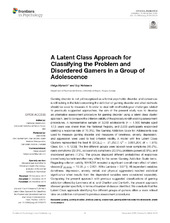| dc.description.abstract | Gaming disorder is not yet recognized as a formal psychiatric disorder, and consensus is still lacking in the field concerning the definition of gaming disorder and what methods should be used to measure it. In order to deal with methodological challenges related to previously suggested approaches, the aim of the present study was to develop an alternative assessment procedure for gaming disorder using a latent class cluster approach, and to compare the criterion validity of this procedure with existing assessment procedures. A representative sample of 3,000 adolescents (n = 1,500 female) aged 17.5 years was drawn from the National Registry, and 2,055 participants responded (yielding a response rate of 70.3%). The Gaming Addiction Scale for Adolescents was used to measure gaming disorder and measures of loneliness, anxiety, depression, and aggression were used to test criterion validity. A model with five Latent Class Clusters represented the best fit [BIC(LL) = 21,253,7; L^2 = 3,881,204; df = 1,978; Class. Err. = 0.1239]. The five different groups were labeled never symptoms (46.2%), rarely symptoms (22.3%), occasionally symptoms (23.5%), problem gamers (6.9%), and disordered gamers (1.2%). The groups displayed different probabilities of responses (never/rarely/sometimes/often/very often) to the seven Gaming Addiction Scale items. Regarding criterion validity, MANOVA revealed a significant overall main effect of latent classes [F_(20, 6359) = 13.50, p < 0.001; Wilks Lambda = 0.871]. All dependent variables (loneliness, depression, anxiety, verbal, and physical aggression) reached statistical significance when results from the dependent variables were considered separately. Comparing the present approach with previous suggested classifications of gaming addiction offered by Lemmens et al. and Charlton and Danforth, the present approach showed greater specificity in terms of number of classes identified. We conclude that the Latent Class approach identifying five different groups of gamers offers a more refined view on addiction compared to previous assessment procedures. | en_US |

